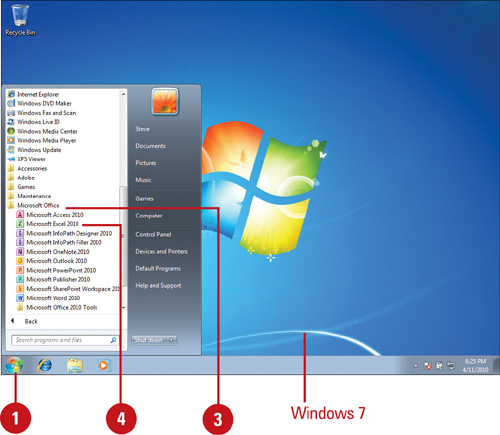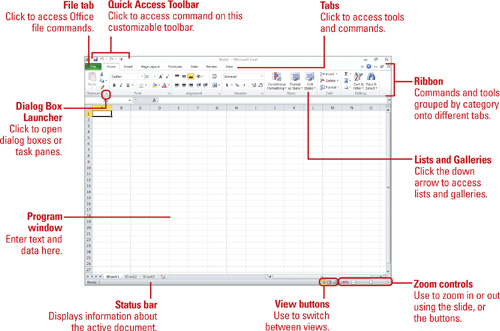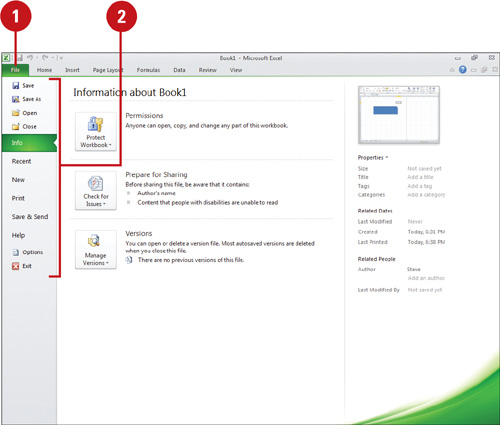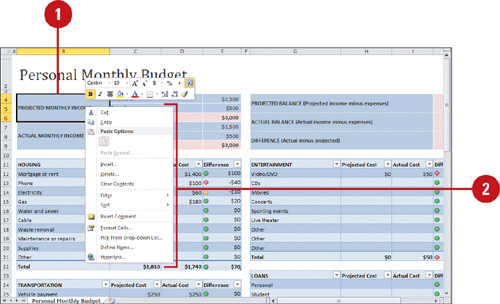Starting Excel
The
two quickest ways to start Excel are to select it on the Start menu or
double-click a shortcut icon on the desktop. By providing different ways
to start a program, Office lets you work the way you like and start
programs with a click of a button. When you start Excel, a program
window opens, displaying a blank workbook, where you can begin working
immediately.
Start Excel from the Start Menu
 Click the Start button on the taskbar.
Click the Start button on the taskbar.
 Point to All Programs.
Point to All Programs.
 Click Microsoft Office.
Click Microsoft Office.
 Click Microsoft Excel 2010.
Click Microsoft Excel 2010.
If Microsoft Office asks you to activate the program, follow the instructions to complete the process.

Timesaver
To
change the product key later, click the File tab, click Help, click the
Change Product Key link, enter the product key, and then click Continue.
Did You Know?
You can create a program shortcut from the Start menu to the desktop.
Click the Start menu, point to All Programs, click Microsoft Office,
right-click Microsoft Excel 2010, point to Send To, and then click
Desktop (Create Shortcut).
You can start Excel and open a workbook from Windows Explorer.
Double-clicking any Excel workbook icon in Windows Explorer opens that file and Excel.
If you’re a power user or
analyst that needs to create bigger, more complex Excel workbooks, you
should use the 64-bit version of Microsoft Excel 2010 (New!).
The 64-bit version of Excel 2010 is built specifically for 64-bit
computers. For example, in the 64-bit version of Excel, you can break
through the physical memory (RAM) limitation of 2 GB that exists with
the 32-bit version, and crunch numbers with ease. If you’re using the
32-bit version, Excel 2010 significantly boosts performance levels (New!)
over previous versions for importing, filtering, sorting, copying, and
pasting large amounts of data, as well as opening and saving large
files.
Viewing the Excel Window

Using the Ribbon
The Ribbon
is a results oriented way of working in Excel 2010. It replaces menus,
toolbars, and most of the task panes found in Excel 2003. The Ribbon is
located at the top of the document window and is comprised of tabs that are organized by task or objects. The controls on each tab are organized into groups, or subtasks. The controls, or command buttons,
in each group execute a command, or display a menu of commands or a
drop-down gallery. Controls in each group provide a visual way to
quickly make document changes. The Office button in Office 2007 has been
replaced by the File tab (New!), which displays Backstage view, where you can access file-related commands.
Timesaver
To minimize the Ribbon, click the Minimize the Ribbon button (Ctrl+F1) (New!) or double-click the current tab. Click a tab to auto display it (Ribbon remains minimized). Click the Expand the Ribbon button (Ctrl+F1) or double-click a tab to maximize it.
If you prefer using the
keyboard instead of the mouse to access commands on the Ribbon,
Microsoft Office provides easy to use shortcuts. Simply press and
release the  or
or  key to display KeyTips
over each feature in the current view, and then continue to press the
letter shown in the KeyTip until you press the one that you want to use.
To cancel an action and hide the KeyTips, press and release the
key to display KeyTips
over each feature in the current view, and then continue to press the
letter shown in the KeyTip until you press the one that you want to use.
To cancel an action and hide the KeyTips, press and release the  or
or  key again. If you prefer using the keyboard shortcuts found in previous
versions of Microsoft Office, such as Ctrl+P (for Print), all the
keyboard shortcuts and keyboard accelerators work exactly the same in
Microsoft Excel 2010. Excel 2010 includes a legacy mode that you can
turn on to use familiar Office Excel 2003 keyboard accelerators.
key again. If you prefer using the keyboard shortcuts found in previous
versions of Microsoft Office, such as Ctrl+P (for Print), all the
keyboard shortcuts and keyboard accelerators work exactly the same in
Microsoft Excel 2010. Excel 2010 includes a legacy mode that you can
turn on to use familiar Office Excel 2003 keyboard accelerators.
Tabs
Excel provides three types of tabs on the Ribbon. The first type is called a standard
tab—such as Home, Insert, Page Layout, Formulas, Data, Review, View,
and Add-Ins—that you see whenever you start Excel. The second type is
called a contextual
tab—such as Picture Tools, Drawing, or Table—that appears only when
they are needed based on the type of task you are doing. Excel
recognizes what you’re doing and provides the right set of tabs and
tools to use when you need them. The third type is called a program tab—such as Print Preview—that replaces the standard set of tabs when you switch to certain views or modes.
Live Preview
When you point to a gallery option, such as WordArt, on the Ribbon, Excel displays a live preview of the option change so that you can see exactly what your change will look like before committing to it.

Choosing Commands
Excel
commands are organized in groups on the Ribbon, Quick Access Toolbar,
and Mini-Toolbar. Commands are available as buttons or options on the
Ribbon, or as menus on button or option arrows or the File tab (New!).
The Quick Access Toolbar and Mini-Toolbar display frequently used
buttons that you may be already familiar with from Excel 2003, while the
File tab on the Ribbon displays file related menu commands in Backstage
view. In addition to the File tab, you can also open a shortcut menu with a group of related commands by right-clicking an element.
Choose a Menu Command Using the File Tab
 Click the File tab on the Ribbon.
Click the File tab on the Ribbon.
 Click the command you want.
Click the command you want.

Timesaver
You
can use a shortcut key to choose a command. Press and hold down the
first key and then press the second key. For example, press and hold the
Ctrl key and then press S (or Ctrl+S) to select the Save command.
Choose a Menu Command from a Shortcut Menu
 Right-click an object (a cell or graphic element).
Right-click an object (a cell or graphic element).
Timesaver
Press Shift+F10 to display the shortcut menu for a selected command.
 Click a command on the shortcut menu. If the command is followed by an
arrow, point to the command to see a list of related options, and then
click the option you want.
Click a command on the shortcut menu. If the command is followed by an
arrow, point to the command to see a list of related options, and then
click the option you want.
